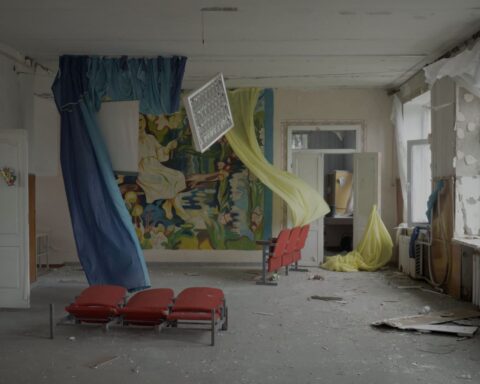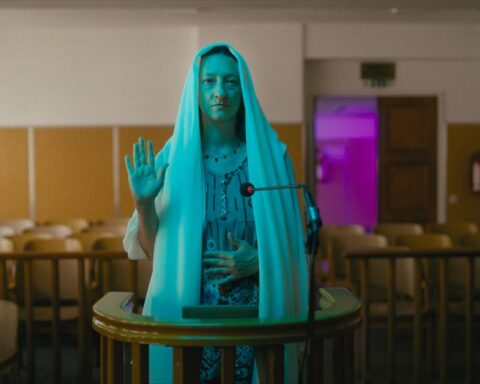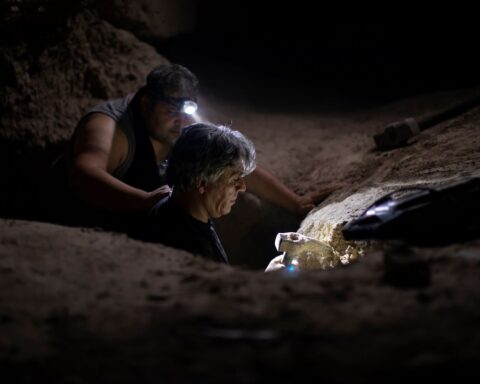“The documentarian ‘bears witness.’ To bear witness is to see and to name … It is an imaginative seeing, a re-visioning that pushes to an authentic re-naming …To see is to engage…The same is true, in a different alchemic reaction, for the audience. I, the viewer, in a most perfect and complete engagement with the work, recreate that dangerous journey of creator and put myself at risk. We all expose ourselves; we all become Sauls on the road to Damascus ….” — Tom Perlmutter, NFB Commissioner
The promise of the new multi-platform world of interactive media can inspire, rather than overwhelm, if we take to heart the vision voiced so eloquently by Tom Perlmutter, NFB Commissioner, at the 2008 Hot Docs International Film Festival. He identifies what filmmakers know: documentary’s power to transform consciousness for creators and audience.
Yes, the required adaptation to the latest digital technologies, whether we are documentary filmmakers or audiences, can seem formidable. It looks like yet one more demand placed on filmmakers’ shoulders, in a relentlessly challenging industry. But it’s necessary to embrace this new media technological learning curve and take storytelling to the next level, not just to reach but also engage audiences as never before in history.
Pioneers in interactive media among documentary filmmakers can inspire us through their successful projects. At a time when broadcasters are losing audiences, the multi-platform, digital universe offers new windows, which call for negotiations between independent producers and broadcasters. The challenges for those who embrace the radically changing documentary industry are where is the funding and who owns what rights?
Kensington Communications’ making of Diamond Road Online (DRO) built upon a decade of its initial interactive projects. “Each project grew incrementally in regard to interactive components,” executive producer Robert Lang told the delegates at the first DOC/IT interactive conference organized by the Ontario section of the Documentary Organization of Canada (DOC) in Toronto last December. Kensington’s 1998 River of Sand project, for example, included a one-hour television documentary. It also initiated a RealAudio format for questions to, and answers from, singer/songwriter Bruce Cockburn and the film team, to be exchanged online during the film shoot. Next, The Sacred Balance, a three- part television series, was accompanied by an interactive web site that showed webcasts with David Suzuki. Both of the interactive projects continue to be available online, at River of Sand INTERACTIVE and SacredBalance.com and the documentary films are still offered for purchase.
The first distinction to note in creating documentaries for multi-platform use is that the film and the content for an interactive web site are separate entities. Diamond Road exists as both a feature film and a three-hour television series while DRO had different requirements. It: (1) had an underlying architecture for online use; (2) the film footage selected for interactive use differed in content from the content in the longer films; and (3) the editing of the online version was executed independently from editing the films. Further key considerations, aside from separate budgets, were ensuring that the online version did not conflict with the broadcast version, nor would “extension licences” compromise the integrity of the content. In other words, corporate diamond mines will not be given online licences. As for initial financing, TVO recognized DRO’s contribution to its “new push into the interactive sphere, and contributed development funds, through Christine McGlade’s digital media department.” Rudy Buttignol (then creative head at TVO) contracted with Kensington at an early stage. In doing so, Buttignol provided an opportunity for Kensington to pitch DRO at IDFA, in order to secure the remaining funds needed internationally. The Bell Broadcast and New Media Fund (Bell Fund) also contributed to DRO’s production, as well as most of the Canadian new media projects to date.
It’s important for the filmmaker to decide, at the onset of a project today, whether s/he is making only a film or, as well, a new media story version. A lot more film footage needs to be shot for dual projects, which, in turn, means more financing. As Marc Le Blanc, TVO’s Director of Business Affairs, advised at DOC/IT: “Lay out everything up front. Put the language on the table at the development phase, in order to be realistic in regard to the ultimate budget.”
For DRO, the footage from the shoot, plus archival content chosen for the online version is presented in a “trans-media approach,” as its co-producer Richard Lachman calls it. “It is not a retelling but instead a different presentation of the story.” The underlying architecture of the web site design consciously provided options for two types of online users: those who “lean forward” to participate as creators or those who “lean back” to enjoy the available range of stories created by the former.”
David Oppenheim, DRO researcher and fellow co-producer, explains, “We wanted to experiment with the content, in order for viewers to engage creatively yet provide guidance to help steer users.” Lachman adds, “The web site can walk you through a story database, or you as consumer/creator can decide where you want to go in order to find information, using key words as guides at entry points.” Multidisciplinary and international content is accessed through the range and number of tags. “The same character can be presented in different facets in different clips,” says Lachman. “The clips are known as ‘tags,’ 400 in this online project, which means a lot of editing.”
In using content different from the initial film, and showing it in tags no longer than three minutes, the online version does not conflict with the broadcasts. But instead, says Lang, “it enhances the television version. We keep our international broadcasters informed as the database grows.”
Indeed, an interactive story is also distinguished in altering the “time signature,” as Lachman calls it. “Online is great for community. You can build a location where people talk to each other.” He adds, “Online combines the social aspect of gaming with social interaction.” It is the community aspect that pulls users back onto the site after the initial visit, as well as the personalized, customized experience. Taking Diamond Road Online global has created an online community in 250 countries and counting.
Lang outlined how his company Kensington Communications is able to continue offering users free online access. “Our model for monetizing the site really is based on the potential to adapt the software—which we own––for subsequent use on our and other sites. As well, we have been investigating a number of potential sources, like licensing the site to broadcasters, video sites, web channels and institutions for whom the rich content we have online is useful for the work they do in education, exhibitions, etc.” Meanwhile, aside from users’ creative input, Kensington has also been able to acquire material that updates the stories, “so they don’t remain frozen in time like in a linear documentary forum.”
SailorJones Media’s interactive The Fundamental Freedoms Project similarly built upon many years of developing interactive skills. Its web site www.charterofrights.ca uses completely different content from the documentary film Fundamental Freedoms. OMNI Television’s Documentary and Drama fund helped development and production of the film initially in seven languages.
he Grapeflix.com web site shows the long form film at a very low fee, linked to The Fundamental Freedoms Project interactive online version. The online version requires Windows XP or higher, in order to facilitate the version 8 MacroMedia Flash Player to access fully the video and audio features. The latter includes interviews with prominent Canadians, transcripts to read along with audio playing in various languages, and vocal clips to stimulate thinking about the impact of the Charter upon us. The Teacher Guides are in English and French but the interactive “Virtual Charter” is shown in more than 20 languages. Experts were hired to write plainly in those diverse tongues.
Executive producer Barbara Jones identified the insertion of more languages when funding was available as one element in the continuing growth of the initial project. The web site reRIGHTS.tv is “a whole new business we are launching,” says Jones, in regard to a “niche social network.” ReRIGHTS.tv’s vision is to engage dialogue and user content that embraces international rights.
Jones points out, “No deal is going to work for every project, so the question is, what will work for your project.” After doing a lot of research, her company chose Grapeflix.com as the host for the long form film’s online audience. “They do digital asset management, and manage a lot of quality bandwidth,” says Jones. She gets a producer-friendly royalty.
What is clearly visible on the two interactive sites are advertisements. SailorJones Media owns outright the interactive site for The Fundamental Freedoms Project. Jones needs ads to cover costs for maintaining a lot of video and audio streaming. “Very good content management is important,” she emphasizes, “to avoid unpaid exploitation and misuse of the interactive project.” “Ad revenues are based on traffic,” she says. “We did more than three million ‘page views’ last year, averaging 250,000 to 300,000 monthly.”
The extended time-line in developing new media is evident in every successful project. It is no different for CineFocus Canada, whose creative team Joan Prowse and John Bessai created an interactive division in 2003. The winning of two awards for their documentary Visions from the Wilderness: The Art of Paul Kane in 2001 inspired them to complete their first prototype web site for From Field to Studio: The Art of Paul Kane in 2002. Doing so was made possible when they were chosen as one of six teams to participate in the Interactive Project Lab at the Canadian Film Centre. Unlike Kensington and SailorJones, CineFocus Canada shot the Paul Kane documentary with no conception of a future interactive project.
Similar to other pioneering interactive filmmakers, Prowse and Bessai learned as they went, and it took until 2008 to fully execute this interactive project. Given From Field to Studio’s focus on the historic and controversial figure of painter Paul Kane, Bessai points out: “Be sure to put in your budget an experienced ethnologist consultant who knows how to design an interactive web site, to render it as easily accessible as possible.”
What distinguishes the Paul Kane project is that an interactive museum exhibit was designed as well as a bilingual 2-DVD kit, which includes the original documentary, plus an interactive adaptation of it, and a teacher’s guide. The museum site design obligated Cinefocus to “enhance the attractiveness” of the project in order to accommodate partners such as museums, galleries and educational institutions. The original film continues to sell independently.
The diversity of partnerships attained by production companies illustrates not just an industry in flux but the breadth of possibilities possible once the creative ingenuity of the filmmaker gets lit up. Yet another spin on becoming a player in the multi-platform universe is for documentary producers to embrace fictional projects. The TV series The Border is a pioneering example by one of Canada’s leading documentary companies White Pine Pictures, founded by Peter Raymont and the late Lindalee Tracey.
The Border, although a drama series, grew out of the extensive frontline research of Raymont and Tracey in creating their three-hour documentary series The Undefended Border. For the latter, they were given unprecedented access to the behind-the-scenes action of immigration and security policing. White Pine Pictures’ partnerships with CBC-TV, the Bell Fund, and Stitch Media have resulted in a unique interactive experience for users. The TV episodes are available online the day after each series is broadcast, says Davida Gragor, White Pine’s marketing head. The interactive web site is licensed to CBC/TV by White Pine Pictures. Gragor adds, “We created the web site in association with Stitch Media, and some of the technology ownership resides with them.”
Enticing potential interactive users to enter this world of intrigue is done through clever tools inserted into the interactive online programme. For example, on the CBC-TV web site for The Border, if you click “Play the Game,” the screen reads: “Warning – You are about to be interrogated.” Gragor points out, “there are two options for the user: either just play a game or, alternatively, sign in to save your progress within a game in order to continue later.” To deepen the true-to-life aura of the stories, when clicking on “Cast,” rather than reading the biographies of the real life actors, the user becomes acquainted with each fictional character through descriptive backgrounds that virtually bring them alive.
The three online games: Interrogation; Surveillance Hunt; and Decoder Ring, were created in a collaboration between interactive producers Evan Jones, owner of Stitch Media, and Julia Bennett, in-house at White Pine Pictures. At the 2008 Banff International Television Festival, The Border Interactive won in the category “Best Mobile Program and Enhancements.”
Stitch Media’s unique QR (Quick Response) code system, designed for use by cell phones coast-to-coast, is the most distinctive interactive component of The Border project. Evan Jones outlined the contest’s vision: “to get people involved in citizen journalism…to be the eyes and ears of justice” through using the cell phone as a camera. “We distributed (QR) bar codes, so those cell phone users could be vigilant regarding any activity relating to border security. Each photo could be entered in the contest. Inspired by the message given in the TV show, we’re putting the power of the press into the hands of the public, because in order to maintain a free society we all need to be involved.”
On the subject of who owns rights in an interactive project, Jones says, “It varies, and can be completely different for each project.” He identifies the four options for inserting interactive media in a film project as: “either a proprietary technology or a ‘to-be-created’ technology (in-house and/or hire an interactive producer), or find a third party (interactive producer), or even use an open source technology.” Separate financing for interactive media is much easier in coordinating a project, Jones advises, because “the world of interactive moves at a different pace. Therefore, to be tied down to [broadcast-based] drawdowns is not useful.”
He further clarifies, “Technology gets classified as software. The negotiated rights of ownership for the interactive software that gets used on a web site is separate from the provider who licences the actual web site.” He identifies a major dilemma for cross-platform pioneers: “Interactive projects do not yet have the ability to generate user fees.”
Prior to launching Stitch Media, Evan Jones was the Creative Director at Xenophile Media. He spearheaded the ReGenesis Extended Reality Game, a groundbreaking integration of interactivity with the TV series ReGenesis, which won two Emmy Awards for Jones and Xenophile. Both the TV series produced by Shaftesbury Films and the interactive web site game, produced by Xenophile Media, have won numerous awards. ReGenesis represents one of the first TV dramas to feature full media convergence.’s Beethoven’s Hair stands as a pioneering convergent documentary, for which the interactive web site continues to be accessible. Thomas Wallner, co-founder of Xenophile Media, was involved in both productions.
At DOC/IT, Wallner listed the pertinent roles of an interactive media team: (1) a whole host of writers; (2) a technical director; (3) a creative director; (4) a head designer; and (5) a user accessibility expert. They’d all be necessary to advise on lots of editing and very high quality graphics. Within the actual interactive design, the considerations, Wallner said, include “different levels of game play as well as different levels of immersion to accommodate users, ranging from: (1) using new media merely for entertainment; (2) collaborating online to contribute to data; and (3) building towards the phenomenon of ‘collective intelligence.’”
Wallner also expressed the perspective, as a producer/writer, that it is preferable for the majority of copyright material to reside with the production company who initiates the interactive components. “It also is important to analyze the various stakeholders and discover their respective expectations.” His wisdom is based on the fact that the ReGenesis Extended Reality Game, first of all, existed only for the first two of four TV seasons of the drama series ReGenesis, and played as a “real time event over months.”
Keith Clarkson, Xenophile’s production manager, subsequently explained that the web site www.regenesistv.com still retains some game elements to play, but at a reduced level, since those TV episodes went off air. Xenophile continues to share hosting of this web site with Shaftesbury Films, Clarkson says, because the web site is “a great showcase for some of the stuff we do.” Now, he adds, “Xenophile prefers to create original productions from scratch, and we own it across all media.” Xenophile’s vision is to negotiate not just broadcaster rights in separate geographic territories but also the internet rights.
Wallner also advises that filmmakers shouldn’t be shy about approaching high profile web sites. For Inside Hana’s Suitcase, another Rhombus Media long form documentary, Xenophile has arranged with YouTube to post online at no cost, partly because the story already comes with an existing audience based on the best-selling children’s book. The online version is planned for launching in November 2008, Clarkson says, adding that it will happen across a variety of web sites, in “a guerrilla marketing campaign” through internet “social network- ing.” Five to 10-minute mini-stories, with interactive environments, will be launched over several weeks.
Another pioneering new media project is the National Film Board’s Filmmaker-in-Residence (FIR) web site, which garnered a 2008 Webby Award (dubbed the “Oscar of the internet”) for filmmaker Katerina Cizek in the category “Best Online Documentary Series” and a Rockie Award at the 2008 Banff Television Festival in the “Internet only program.”
What distinguishes FIR is that “multi-platform,” in this case, goes beyond online participation, encompassing community-based participation where the tar hits the road. In the hospital and on the streets, FIR put cameras into the hands of the disadvantaged, to relate their own stories and strengthen their sense of dignity. “Our collaboration has been very organic,” said Cizek, emphasizing: “The biggest investment the NFB made was time … building relationships.” Noteworthy, as well, is: “In this type of project, all the ideas and goals originated in the community in which we worked.” This project’s multiple worlds impact on: medicine, academia, corporations, documentary film, new media, community advocacy, various DVDs, public photo exhibits, more than a hundred community-based workshops, and participatory media workshops. The latter Cizek now has taken internationally, at the June 2008 EsoDoc (European Social Documentary) “think tank,” in Italy.
The DOC Agora Association is ensuring that Canadian filmmakers are digitally literate. Its mandate is to train filmmakers and develop marketplaces for new media productions. DOC Agora’s online vision is to build a “virtual webplex” for new forms of storytelling and provide information about new systems of financing. Real world DOC Agora events have been conducted in Australia, Europe and the USA.
In April 2008, at Hot Docs in Toronto, DOC Agora hosted two international panel discussions on the multi- platform landscape. Prior to Hot Docs, the inaugural NFB–DOC Agora Ontario Convergence Lab, held at the Canadian Film Centre (CFC), gave four maverick film companies the opportunity to present their projects to international digital documentary experts and financiers.
Aside from the NFB, CFC and Hot Docs, other DOC Agora partners for the above events included: DOC Toronto, DOC National, Ryerson University, Ontario College of Art and Design, Bravo!FACT, Interactive Ontario, The Centre for Social Media, the DOC Agora Association (DAO), and Bell Broadcast and New Media Fund (Bell Fund). International partnerships are being developed in a world now more globally linked than ever before through the digital evolution.
In Canada, the Bell Fund’s Executive Director Andra Scheffer gives presentations at filmmaking events to demystify their rigorous guidelines; the organization also offers new media training programmes. While the Fund’s mandate is “to support the broadcasting system in Canada,” its criteria for funding independent producers provides excellent advice to embark on any new media project. (For guidelines, see www.bellfund.ca)
“Twenty-five per cent of our funding goes to documentaries,” says Scheffer. Stand-alone documentaries are eligible, if the project has a strong multimedia component that gives it a long life. She adds, “Driving traffic is a big issue with a one-off.” Longevity plus different revenue models are two pluses. One model is to sell video clips from the filmmaker’s web site to other sites. Strategies include versioning in different languages for further broadcast sales, and working with “aggregators,” who offer the skill of putting together sources (clips) to sell off. Scheffer clarifies: “Aggregators are packagers, not distributors, and operate separately from distributors.”
“Make sure that tags and search engines all work to encourage traffic, to visit both your web site and also the broadcaster,” she says. When a filmmaker already has a successful web site that attracts a lot of users, it can be the basis of a filmmaker then approaching a broadcaster and the Bell Fund. “We can only fund once you have a broadcast licence.”
“As for the future site attached to a specific project, the new media producer must own rights to the web site, whereas the broadcaster can host or partner,” says Scheffer, noting “the broadcaster only hosts your web site as long as the television licence lasts.” Sometimes the Bell Fund will provide funding up to $50,000 to maintain your project site.” Independent producers “negotiate with the broadcaster whether you create your own stand-alone web site or, alternatively, it hosts the site for your project.” Also important, when a producer first approaches the Bell Fund is, not only to know who your target audience is but, moreover, how your online version will interact with the televised version. Furthermore, identify the creative team with whom you are working to carry out the necessary technologies.
Though new media’s interface with film is still growing, documentary filmmakers are demonstrating that they can be successful in the multi-platform universe. More funding sources will become available, of necessity, for all players in a global film and broadcast industry. The industry may be in flux, but it’s responding creatively to the unfolding challenges.
The rights issue, also in flux, is a critical aspect of new media. The deals being made between independent producers and broadcasters are influencing the landscape in which everyone operates.
Even as the ground continues to shift, the best that independent producers can do is to arm themselves with as much up-to-date information as possible and challenge unreasonable policies that threaten freedom of expression. At the same time, independent producers should secure the appropriate rights to enable successful, lasting multi-form projects. Check out web sites, such as DOC Agora at www.docagora.ca, DOC at www.docorg.ca, and the Canadian Interactive Alliance/Alliance interactive canadienne, and its provincial members, at www.ciaic.ca.
Rights are not written in stone, and given the new media landscape, former agreements now must be renegotiated. Indeed, Terms of Trade were named as a potentially meaningful addition to the industry, in a paper presented by co-authors/filmmakers Danijel Margetic and Andrea Nemtin at Hot Docs DOC Summit. (Their report is now available on www.docorg.ca.)
In an industry changing by the month, or so it may seem, advice given by lawyer Richard Hanet, on last December’s DOC/IT legal/business panel, still holds. He suggested: (1) Discuss who gets what rights at the early stage, when discussing the concept of the documentary; (2) The independent producer has the obligation to be informed in calculating potential revenue outlets prior to this discussion with the broadcaster; and (3) in terms of trade, profit margins, both for the producer and also broadcaster, must be considered. For example, if a broadcaster offers only 40 per cent, then the producer can demand keeping more rights when put in the position of looking elsewhere for the necessary funding.
The key ingredient for success remains the same: form excellent partnerships. The win-win relationship between TVO and Diamond Road Online shows that producers and broadcasters can work well together. Evan Jones knows it too: “Find somebody who is as passionate about their platform as you are about yours, and open up to the relationship. The best projects are when both producers are working together towards the same goals.”











